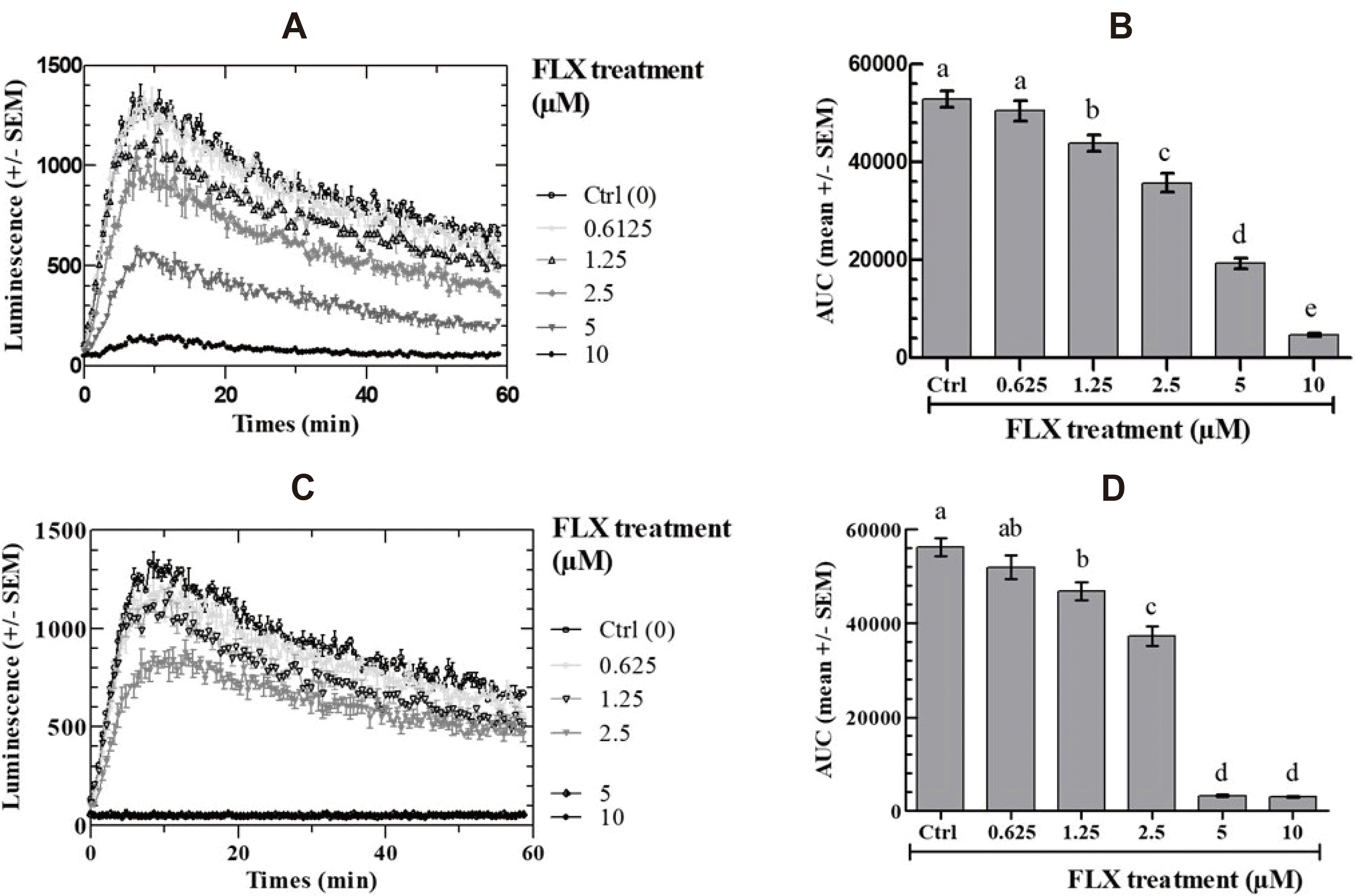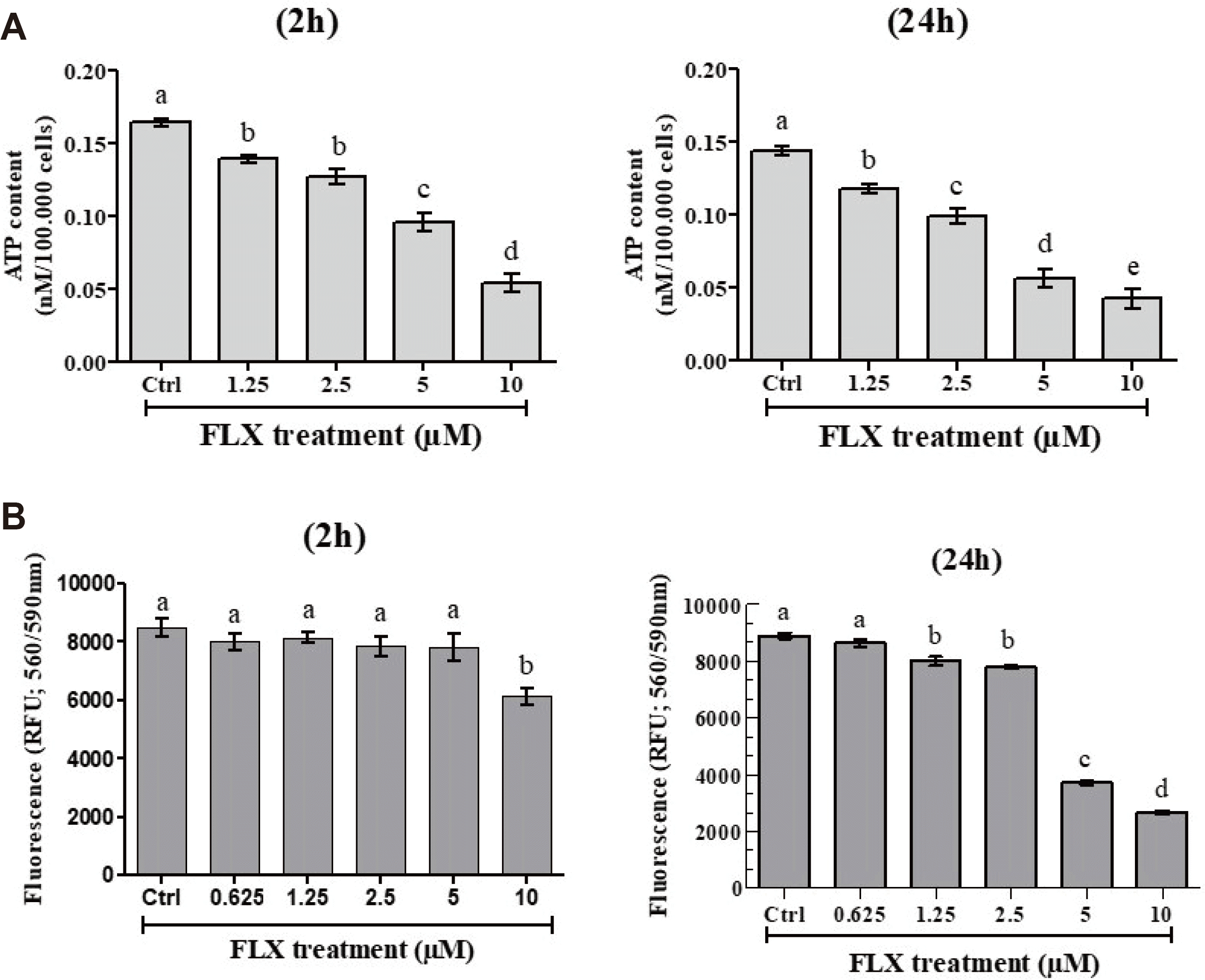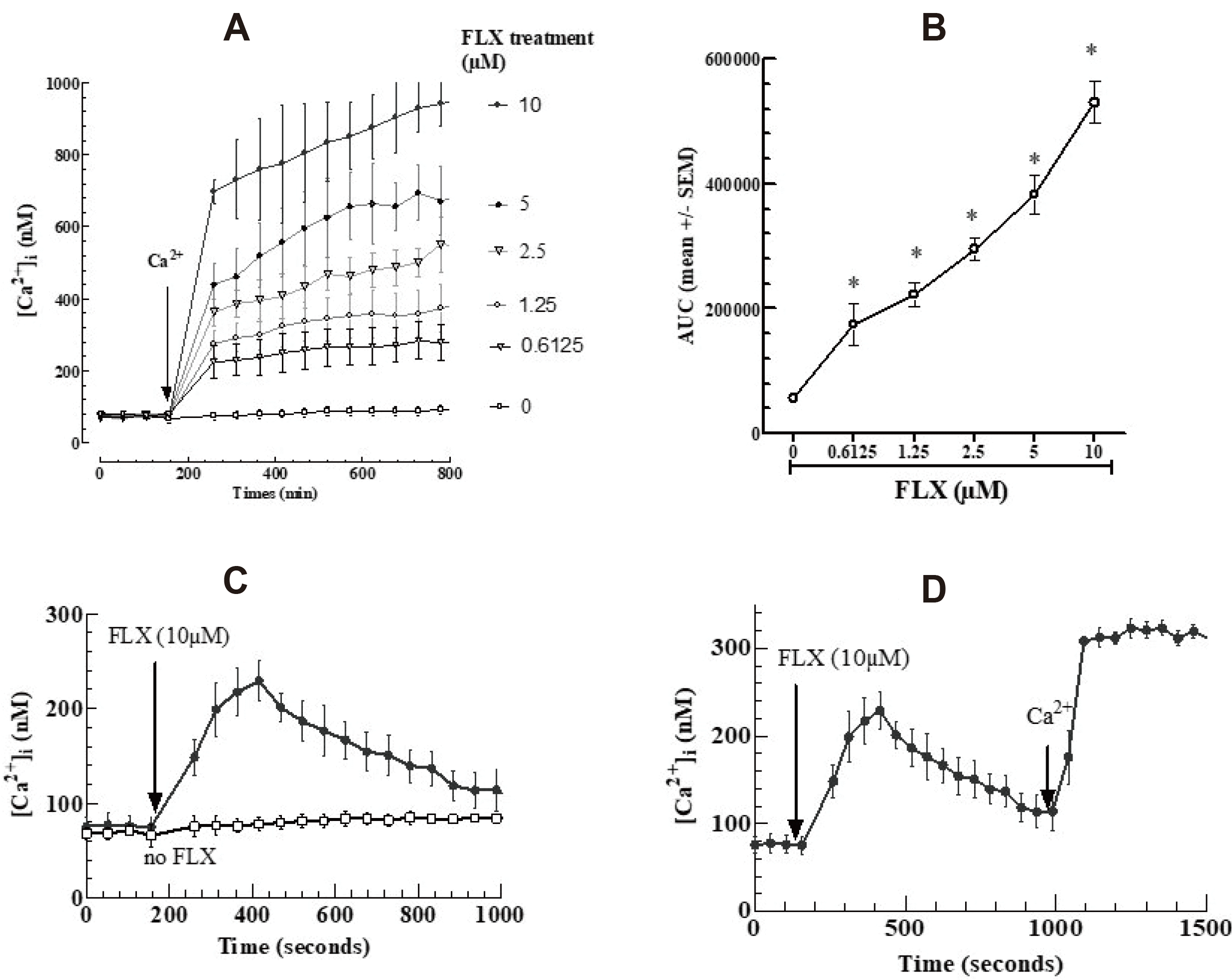1. Wong DT, Bymaster FP, Engleman EA. 1995; Prozac (fluoxetine, Lilly 110140), the first selective serotonin uptake inhibitor and an antidepressant drug: twenty years since its first publication. Life Sci. 57:411–441. DOI:
10.1016/0024-3205(95)00209-O. PMID:
7623609.


2. Stark P, Fuller RW, Wong DT. 1985; The pharmacologic profile of fluoxetine. J Clin Psychiatry. 46(3 Pt 2):7–13. PMID:
3871767.

3. Fuller RW, Wong DT, Robertson DW. 1991; Fluoxetine, a selective inhibitor of serotonin uptake. Med Res Rev. 11:17–34. DOI:
10.1002/med.2610110103. PMID:
1994152.


4. Pancrazio JJ, Kamatchi GL, Roscoe AK, Lynch C 3rd. 1998; Inhibition of neuronal Na+ channels by antidepressant drugs. J Pharmacol Exp Ther. 284:208–214. PMID:
9435180.
5. Deák F, Lasztóczi B, Pacher P, Petheö GL, Kecskeméti V, Spät A. 2000; Inhibition of voltage-gated calcium channels by fluoxetine in rat hippocampal pyramidal cells. Neuropharmacology. 39:1029–1036. DOI:
10.1016/S0028-3908(99)00206-3. PMID:
10727713.


6. Mukherjee J, Das MK, Yang ZY, Lew R. 1998; Evaluation of the binding of the radiolabeled antidepressant drug, 18F-fluoxetine in the rodent brain: an in vitro and in vivo study. Nucl Med Biol. 25:605–610. DOI:
10.1016/S0969-8051(98)00043-2. PMID:
9804041.


8. Maurice DH, Palmer D, Tilley DG, Dunkerley HA, Netherton SJ, Raymond DR, Elbatarny HS, Jimmo SL. 2003; Cyclic nucleotide phosphodiesterase activity, expression, and targeting in cells of the cardiovascular system. Mol Pharmacol. 64:533–546. DOI:
10.1124/mol.64.3.533. PMID:
12920188.


9. Jin L, Hill KK, Filak H, Mogan J, Knowles H, Zhang B, Perraud AL, Cambier JC, Lenz LL. 2011; MPYS is required for IFN response factor 3 activation and type I IFN production in the response of cultured phagocytes to bacterial second messengers cyclic-di-AMP and cyclic-di-GMP. J Immunol. 187:2595–2601. DOI:
10.4049/jimmunol.1100088. PMID:
21813776. PMCID:
PMC3159690.



10. Berridge MJ, Bootman MD, Roderick HL. 2003; Calcium signalling: dynamics, homeostasis and remodelling. Nat Rev Mol Cell Biol. 4:517–529. DOI:
10.1038/nrm1155. PMID:
12838335.


11. Berridge MJ, Lipp P, Bootman MD. 2000; The versatility and universality of calcium signalling. Nat Rev Mol Cell Biol. 1:11–21. DOI:
10.1038/35036035. PMID:
11413485.


12. Carafoli E, Santella L, Branca D, Brini M. 2001; Generation, control, and processing of cellular calcium signals. Crit Rev Biochem Mol Biol. 36:107–260. DOI:
10.1080/20014091074183. PMID:
11370791.


15. Nguyen TMD, Klett D, Filliatreau L, Combarnous Y. 2019; Inhibition by fluoxetine of LH-stimulated cyclic AMP synthesis in tumor Leydig cells partly involves AMPK activation. PLoS One. 14:e0217519. DOI:
10.1371/journal.pone.0217519. PMID:
31163038. PMCID:
PMC6548379.

16. Zhang H, Vollmer M, De Geyter M, Litzistorf Y, Ladewig A, Dürrenberger M, Guggenheim R, Miny P, Holzgreve W, De Geyter C. 2000; Characterization of an immortalized human granulosa cell line (COV434). Mol Hum Reprod. 6:146–153. DOI:
10.1093/molehr/6.2.146. PMID:
10655456.


17. Curti C, Mingatto FE, Polizello AC, Galastri LO, Uyemura SA, Santos AC. 1999; Fluoxetine interacts with the lipid bilayer of the inner membrane in isolated rat brain mitochondria, inhibiting electron transport and F1F0-ATPase activity. Mol Cell Biochem. 199:103–109. DOI:
10.1023/A:1006912010550. PMID:
10544958.

18. Gincel D, Zaid H, Shoshan-Barmatz V. 2001; Calcium binding and translocation by the voltage-dependent anion channel: a possible regulatory mechanism in mitochondrial function. Biochem J. 358(Pt 1):147–155. DOI:
10.1042/bj3580147. PMCID:
PMC1222042. PMID:
11485562.



19. Rostovtseva T, Colombini M. 1997; VDAC channels mediate and gate the flow of ATP: implications for the regulation of mitochondrial function. Biophys J. 72:1954–1962. DOI:
10.1016/S0006-3495(97)78841-6. PMID:
9129800. PMCID:
PMC1184392.



20. Hodge T, Colombini M. 1997; Regulation of metabolite flux through voltage-gating of VDAC channels. J Membr Biol. 157:271–279. DOI:
10.1007/s002329900235. PMID:
9178614.


21. Shoshan-Barmatz V, Gincel D. 2003; The voltage-dependent anion channel: characterization, modulation, and role in mitochondrial function in cell life and death. Cell Biochem Biophys. 39:279–292. DOI:
10.1385/CBB:39:3:279. PMID:
14716081.


22. Nahon E, Israelson A, Abu-Hamad S, Varda SB. 2005; Fluoxetine (Prozac) interaction with the mitochondrial voltage-dependent anion channel and protection against apoptotic cell death. FEBS Lett. 579:5105–5110. DOI:
10.1016/j.febslet.2005.08.020. PMID:
16139271.


23. Charles E, Hammadi M, Kischel P, Delcroix V, Demaurex N, Castelbou C, Vacher AM, Devin A, Ducret T, Nunes P, Vacher P. 2017; The antidepressant fluoxetine induces necrosis by energy depletion and mitochondrial calcium overload. Oncotarget. 8:3181–3196. DOI:
10.18632/oncotarget.13689. PMID:
27911858. PMCID:
PMC5356874.


24. Costa-Junior HM, Mendes AN, Davis GH, da Cruz CM, Ventura AL, Serezani CH, Faccioli LH, Nomizo A, Freire-de-Lima CG, Bisaggio Rda C, Persechini PM. 2009; ATP-induced apoptosis involves a Ca
2+-independent phospholipase A2 and 5-lipoxygenase in macrophages. Prostaglandins Other Lipid Mediat. 88:51–61. DOI:
10.1016/j.prostaglandins.2008.09.004. PMID:
18984060.

25. Sakanashi Y, Oyama TM, Matsuo Y, Oyama TB, Nishimura Y, Ishida S, Imai S, Okano Y, Oyama Y. 2009; Zn
2+, derived from cell preparation, partly attenuates Ca
2+-dependent cell death induced by A23187, calcium ionophore, in rat thymocytes. Toxicol In Vitro. 23:338–345. DOI:
10.1016/j.tiv.2008.12.006. PMID:
19124067.

26. Kannen V, Hintzsche H, Zanette DL, Silva WA Jr, Garcia SB, Waaga-Gasser AM, Stopper H. 2012; Antiproliferative effects of fluoxetine on colon cancer cells and in a colonic carcinogen mouse model. PLoS One. 7:e50043. DOI:
10.1371/journal.pone.0050043. PMID:
23209640. PMCID:
PMC3507893.

27. Cloonan SM, Williams DC. 2011; The antidepressants maprotiline and fluoxetine induce Type II autophagic cell death in drug-resistant Burkitt's lymphoma. Int J Cancer. 128:1712–1723. DOI:
10.1002/ijc.25477. PMID:
20503272.


28. Lee CS, Kim YJ, Jang ER, Kim W, Myung SC. 2010; Fluoxetine induces apoptosis in ovarian carcinoma cell line OVCAR-3 through reactive oxygen species-dependent activation of nuclear factor-kappaB. Basic Clin Pharmacol Toxicol. 106:446–453. DOI:
10.1111/j.1742-7843.2009.00509.x. PMID:
20050848.

29. Brambilla P, Cipriani A, Hotopf M, Barbui C. 2005; Side-effect profile of fluoxetine in comparison with other SSRIs, tricyclic and newer antidepressants: a meta-analysis of clinical trial data. Pharmacopsychiatry. 38:69–77. DOI:
10.1055/s-2005-837806. PMID:
15744630.


31. Rizzuto R, Marchi S, Bonora M, Aguiari P, Bononi A, De Stefani D, Giorgi C, Leo S, Rimessi A, Siviero R, Zecchini E, Pinton P. 2009; Ca
2+ transfer from the ER to mitochondria: when, how and why. Biochim Biophys Acta. 1787:1342–1351. DOI:
10.1016/j.bbabio.2009.03.015. PMID:
19341702. PMCID:
PMC2730423.


32. Spät A, Szanda G, Csordás G, Hajnóczky G. 2008; High- and low-calcium-dependent mechanisms of mitochondrial calcium signalling. Cell Calcium. 44:51–63. DOI:
10.1016/j.ceca.2007.11.015. PMID:
18242694. PMCID:
PMC2662195.



33. Rasola A, Bernardi P. 2011; Mitochondrial permeability transition in Ca
2+-dependent apoptosis and necrosis. Cell Calcium. 50:222–233. DOI:
10.1016/j.ceca.2011.04.007. PMID:
21601280.

35. Leist M, Single B, Castoldi AF, Kühnle S, Nicotera P. 1997; Intracellular adenosine triphosphate (ATP) concentration: a switch in the decision between apoptosis and necrosis. J Exp Med. 185:1481–1486. DOI:
10.1084/jem.185.8.1481. PMID:
9126928. PMCID:
PMC2196283.










 PDF
PDF Citation
Citation Print
Print


 XML Download
XML Download